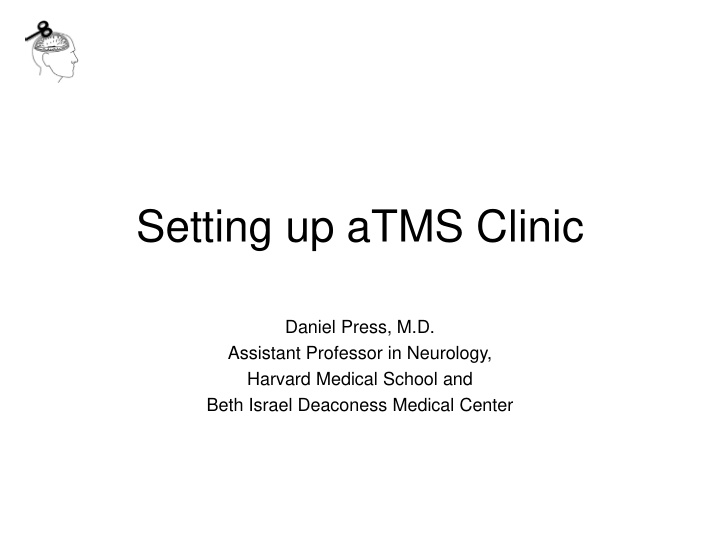



Setting up aTMS Clinic Daniel Press, M.D. Assistant Professor in Neurology, Harvard Medical School and Beth Israel Deaconess Medical Center
Contents • Safety and training of personnel Starting program • Equipment • Certification • Evaluation and Consent • Treatment Protocol Managing patients • Assessment • Maintenance • Cost/Billing Long term plans • Future Developments
Personnel • Clinicians (Neurology / Psychiatry) • Administrative support – Scheduling – Providing information to prospective patients – Data collection • Technicians – TMS trained – Basic Life Support – Patient interaction
Safety • Patient selection- seizure risk • TMS protocol- 10-20hz vs. 1hz • Safety equipment – In hospital – Clinic/outpatient setting • Training of staff in management of seizures
Equipment • TMS machine – Approved device options – Cooled coil – We use both neuronetics and magstim • Earplugs and swimming caps • Safety equipment – Tylenol – To treat a seizure – Emergency medical services
Neurostar TMS Therapy System Treatment Coil Display Senstar TM Treatment Link • Contact sensing • Dose confirmation • Surface field cancellation Mobile Console • Hygiene barrier
TMS Timeline 1984 1987 1996 2007 2008 2012 2013-4 FDA NHIC Coverage from clearance Medicare Most insurers, Approval Brainsway (MA,NH,VT Clearance and RI) Pascual-Leone, et. al. Cadwell George, et. al. Repetitive TMS rTMS for depression (rTMS) Anthony Barker Single Pulse TMS Neuronetics Phase III trial of rTMS for Medication-resistant depression
Devices and Financial Models Manuf. Neuronetics Brainsway Magstim FDA cleared for Yes Yes No depression: Purchase model Mixed Rental Purchase (Purchase + starstim)
Initial Evaluation • Referral from treating psychiatrist • Neurology – Contraindications – Effect of medication on TMS • Psychiatry – Caution if: Psychotic depression, bipolar, personality disorders – At least one adequate trial of antidepressant medication
How we saw it…
How Lean Saw it…
Consent • Local ethical/safety committee (not IRB!) • Discussion of on-label vs. off-label treatment • Explanation of side-effects – Seizure – Headache – Tinnitus/hearing loss
BIDMC Treatment Protocol Site Hemisphere Frequency Duration Wait time Repetitions Neuronetics Left DLPFC 10 Hz 4 seconds 26 75 (120% MT) seconds (3000 pulses) DLPFC Right 1 Hz 1600 N/A 1 (110% MT) seconds (1600 pulses) Brainsway Left DLPFC 18 Hz 2 seconds 20 55 (120% MT) seconds (1980 pulses) DLPFC Left DLPFC 20 Hz 2 seconds 28 40 (5.5 cm) (110% MT) seconds (1600 pulses)
Initiation Phase • Treatments daily (excluding weekends) • Mood assessed weekly • Minimum 2 weeks • Maximum 6 weeks • Taper?
Alternatives being investigated • Choosing protocol on clinical parameters (anxiety, risk of mania/sz) • Using MRI guidance for targeting • Using anatomical MRI to help with intensity of stimulation (particularly in elderly) • Others: mood induction, more than one session/day
Assessment tools • Beck, Hamilton, Analogue scale • Target symptoms • Clinician evaluation of patient • Other sources of information (e.g. family, referring psychiatrist) • Side effects questionnaire • Weekly meeting of all staff to discuss progress
Overall Results from Clinical Program 50 45 BDI score (mean +/- SD) 40 35 30 25 20 15 10 5 N=170 n=165 n=146 n=123 n=71 0 1 Baseline Week 1 Week 2 Week 3 Week 4 Time
Maintenance Phase • Minimal evidence (absence of evidence, not evidence of absence) • Relapse prevention – Start with weekly treatment – Gradually space out sessions • “ Watchful Waiting ” /reinduction – Patient presents when feeling worse
Maintenance: Initial Course Maint 1 week Q 2 weeks Q 3-4 weeks Reinduction: Initial Course Taper 2 to 1x/wk Stop if relapse 2-3/wk Taper
Cost • Medicare coverage in 4 of 12 districts • Insurance Coverage • $400-$500 initial session with MT, then $350-$400 non-MT session • How frequently to measure MT? • Helping with reimbursement, creating fund for low income patients
Future Developments • Multiple devices with different economic models (Brainsway, Magstim, MagPro, etc) • Maintaining/improving quality • New indications (neuropathic pain, PD, AD, epilepsy, stroke recovery, etc)
Percent Improvement (NIBS – Sham) 0 10 20 30 40 50 60
Reimbursement for TMS • Currently its approved by most payers (Medicare, BC/BS, Tufts) • Each carrier has slightly different criteria • New devices are coming on line
Future Developments • Targeting (use of structural MRI ’ s and fMRI ’ s for intensity and targeting?) • Interaction of rTMS with medications • Predictors of response • Monitoring response biologically • Other indications (pain, seizures, stroke recovery, Parkinson ’ s disease)
Recommend
More recommend